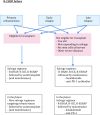Diffuse large B-cell lymphoma: R-CHOP failure-what to do?
- PMID: 27913503
- PMCID: PMC6142522
- DOI: 10.1182/asheducation-2016.1.366
Diffuse large B-cell lymphoma: R-CHOP failure-what to do?
Abstract
Although rituximab plus cyclophosphamide, doxorubicin, vincristine, and prednisone (R-CHOP) is the standard treatment for patients with diffuse large B-cell lymphoma (DLBCL), ∼30% to 50% of patients are not cured by this treatment, depending on disease stage or prognostic index. Among patients for whom R-CHOP therapy fails, 20% suffer from primary refractory disease (progress during or right after treatment) whereas 30% relapse after achieving complete remission (CR). Currently, there is no good definition enabling us to identify these 2 groups upon diagnosis. Most of the refractory patients exhibit double-hit lymphoma (MYC-BCL2 rearrangement) or double-protein-expression lymphoma (MYC-BCL2 hyperexpression) which have a more aggressive clinical picture. New strategies are currently being explored to obtain better CR rates and fewer relapses. Although young relapsing patients are treated with high-dose therapy followed by autologous transplant, there is an unmet need for better salvage regimens in this setting. To prevent relapse, maintenance therapy with immunomodulatory agents such as lenalidomide is currently undergoing investigation. New drugs will most likely be introduced over the next few years and will probably be different for relapsing and refractory patients.
© 2016 by The American Society of Hematology. All rights reserved.
Conflict of interest statement
Conflict-of-interest disclosure: B.C. is on the board of directors or an advisory committee for Celgene, Celltrion, MorphoSys, and Pfizer and has consulted for Gilead and Novartis. C.S. declares no competing financial interests.
Figures
References
-
- Teras LR, DeSantis CE, Cerhan JR, Morton LM, Jemal A, Flowers CR. 2016 US lymphoid malignancy statistics by World Health Organization subtypes [published online ahead of print 12 September 2016]. CA Cancer J Clin. doi: 10.3322/caac.21357. - PubMed
-
- Coiffier B, Thieblemont C, Van Den Neste E, et al. . Long-term outcome of patients in the LNH-98.5 trial, the first randomized study comparing rituximab-CHOP to standard CHOP chemotherapy in DLBCL patients: a study by the Groupe d’Etudes des Lymphomes de l’Adulte. Blood. 2010;116(12):2040-2045. - PMC - PubMed
-
- Sarkozy C, Traverse-Glehen A, Coiffier B. Double-hit and double-protein-expression lymphomas: aggressive and refractory lymphomas. Lancet Oncol. 2015;16(15):e555-e567. - PubMed
-
- Xu-Monette ZY, Dabaja BS, Wang X, et al. . Clinical features, tumor biology, and prognosis associated with MYC rearrangement and Myc overexpression in diffuse large B-cell lymphoma patients treated with rituximab-CHOP. Mod Pathol. 2015;28(12):1555-1573. - PubMed
Publication types
MeSH terms
Substances
LinkOut - more resources
Full Text Sources
Other Literature Sources
Medical
Research Materials



